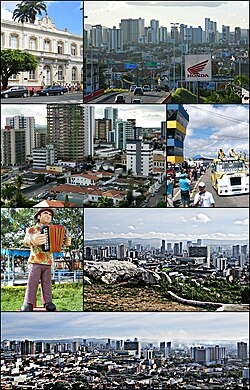Caruaru
|
Caruaru Município de Caruaru |
||
|---|---|---|
| Municipality | ||
| Municipality of Caruaru | ||
 |
||
|
||
| Coordinates: 08°16′58″S 35°58′33″W / 8.28278°S 35.97583°WCoordinates: 08°16′58″S 35°58′33″W / 8.28278°S 35.97583°W | ||
| Country |
|
|
| Region | Northeast | |
| State |
|
|
| Founded | 1849 | |
| Government | ||
| • Mayor | José Queiroz (PDT) | |
| Area | ||
| • Total | 920.61 km2 (355.45 sq mi) | |
| Elevation | 545 m (1,788 ft) | |
| Population (2010) | ||
| • Total | 354,951 | |
| • Density | 324.2/km2 (840/sq mi) | |
| Time zone | UTC−3 (UTC-3) | |
| • Summer (DST) | UTC−3 (UTC-3) | |
| Postal code | 55000-000 | |
| Area code(s) | +55 81 | |
| HDI (2000) | 0.713 – medium | |
| Website | www |
|
Caruaru is a Brazilian municipality in the state of Pernambuco. The most populous city in the interior of the state, Caruaru is located in the microzone of Agreste and because of its cultural importance, it is nicknamed Capital do Agreste (Portuguese for the "capital city of the Agreste region"), Princesinha do Agreste ("Little Princess of Agreste"), and Capital do Forró ("the capital city of forró").
The city is located 140 kilometers (87 miles) from the state capital of Recife, which has an international airport. However Caruuaru has its own airport. Caruaru is renowned for its extensive Festival de São João ("Saint John's Festival"), which takes up the whole month of June, sometimes extending into July. Caruaru had a 2010 resident population of 354,951 inhabitants, living in a land area of 920.61 square kilometers (355.45 square miles).
Caruaru is the hometown, among others, of Álvaro Lins, Brazilian journalist, and Lieutenant Brigadier Reginaldo dos Santos, former dean of the Brazilian Technological Institute for Aeronautics.
The lands that today comprise the city of Caruaru were originally a cattle ranch owned by family Nunes dos Bezerros. This name was given because of the proximity of the farm to the Bezerros chapel. Some orphans used to live with the Nunes family. One of them, José Rodrigues de Jesus, inherited part of the estate, staying at the location that would later be named Caruaru. There he built a chapel dedicated to the Immaculate Conception. A village started to grow around this chapel. In 1846, Friar Euzébio de Sales started to build the parish named Igreja Matriz, nowadays a cathedral. In later years, the church was rebuilt twice, the last one in 1883. The geographical position benefited the city, because it was a necessary stopover in the transportation of cattle to the interior of the state.
...
Wikipedia


